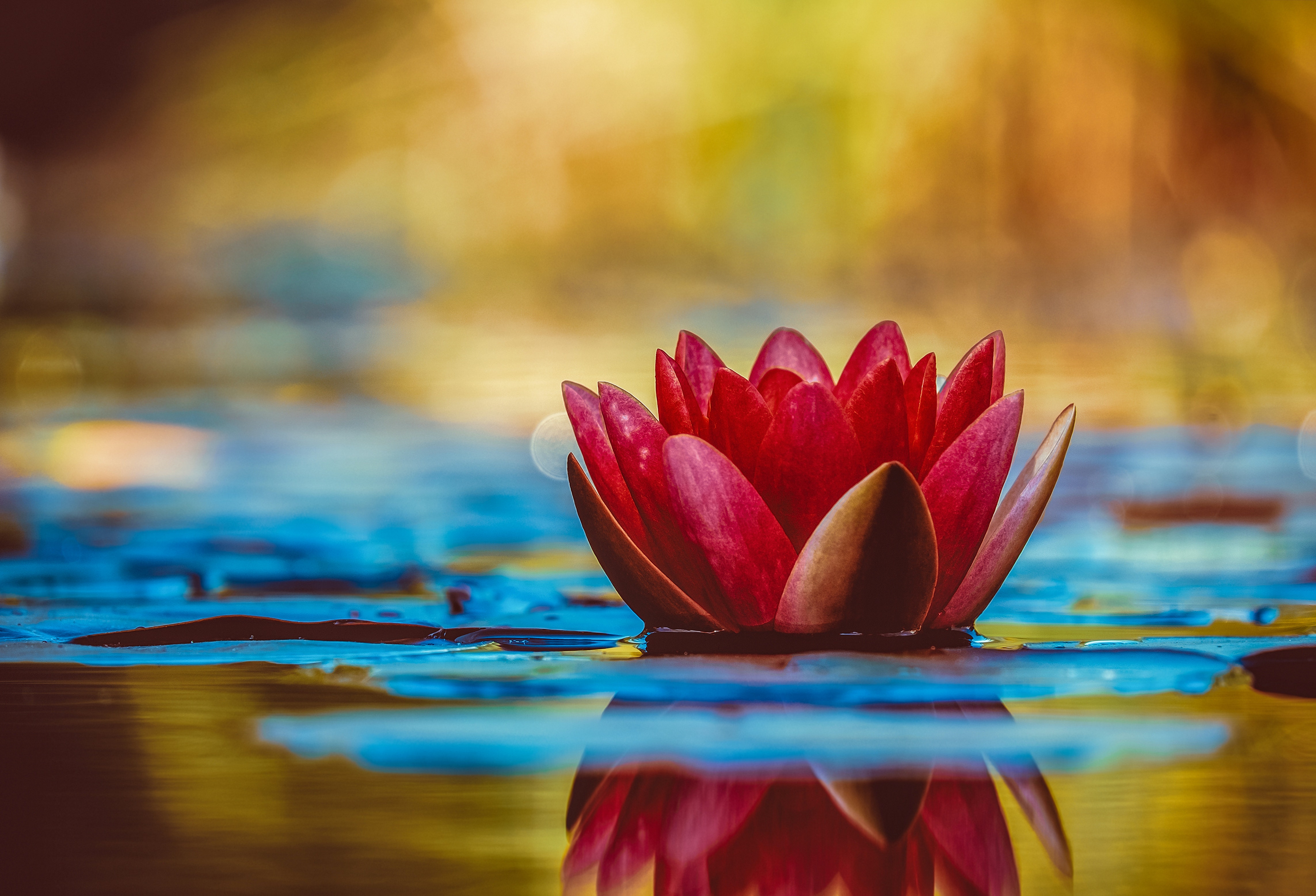Grief, much like the changing seasons, has its own rhythm and pace. Initially, the overwhelming shock and pain may feel like the intense rains of fall, where the skies open up and pour down relentlessly. Tears, like raindrops, come fast and heavy, and when the clouds clear up, the biting cold swoops in, where reality feels unbearable, just like the harshness of winter.
As ancient wisdom teaches us, time heals all wounds. Even after the darkest days, spring comes, and it brings peace and acceptance.
But for those of us who feel or have ever felt stuck in an endless winter of grieving, how can we welcome spring into our broken hearts?
Psychologists recommend therapy, physical activity, and reconnecting with the people around us. I personally found this very therapeutic. When I was dealing with the loss of my grandpa, the yoga movements and poses, or asanas, provided a physical outlet for my pain, while meditation and mindfulness practices helped me process my emotions and accept my new reality.
Because of this, I want to share with you what I know and have learned through my experiences, hoping that I bring a little bit of comfort to someone else.
The Psychology of Grief and Loss
At its core, grief is our emotional response to loss. It's a natural part of what makes us human, and believe it or not, it's our brain's way of helping us cope.
When we grieve, our brain releases stress hormones, which, in moderation, can be protective. They sharpen our senses, keep us alert, and even help us form memories. But prolonged exposure to these hormones, especially in the acute stages of grief, can leave us feeling overwhelmed, anxious, and numb.

The Grieving Process
Elisabeth Kübler-Ross, a renowned psychiatrist, introduced a model that defines grief through five stages: denial, anger, bargaining, depression, and acceptance. Of course, it's important to know that not all of us will go through all these stages or in this order, and some might revisit the stages multiple times.
However, experts agree that these emotional states represent the typical emotional responses most people go through while grieving.
Denial is like a shock absorber and serves as a protective shield from the realization and immediate pain. It often leads to anger, the next phase, as reality sets in. Bargaining is a hopeful attempt to postpone or delay the inevitable. This is when people say things like, “If only I could have one more moment with them,” before the silence and emptiness of sadness (depression) take over.
Finally, after some time and a lot of healing, acceptance slowly enters the door as we come to terms with our new reality. But it doesn’t mean that the pain will disappear or that we've forgotten our loved ones. Think of it as a gentle embrace of the present moment, a realization that life, with all its ups and downs, continues.
In theory, this is the process of grief. In practice, it’s not uncommon for us to become stuck in a repetitive loop, unable to move on.
The Never Ending Loop
The psychological perspective on grief helps us understand the process so we’re kinder to ourselves while going through it. But unfortunately, this knowledge doesn’t give us the power to control our emotions. And that’s okay.
Some days, we feel a profound sense of acceptance. On other days, we find ourselves back in the depths of anger or sadness. It's all part of the healing process, or at least until it begins to impair our ability to live a fulfilling life.
Prolonged grief can take a significant toll on our mental and emotional well-being. When the weight of loss lingers heavily on our hearts for an extended period, it can lead to feelings of chronic sadness, detachment, and even physical symptoms like fatigue or insomnia. This is our brain's way of signaling that the burden is becoming too heavy to bear.
During these times, it’s essential to find coping mechanisms that resonate with us and provide solace and a path to healing.
Finding Solace In Connection
Along the turbulent path of emotions brought on by grief — the surprising waves of acceptance followed by the undertow of anger or sadness — there lies a quiet, often unspoken truth. Healing isn't a solitary journey. Our emotions are deeply personal, but the need for connection, for sharing our burden with others, is universal.
Yet, while we grieve, the world can feel both overwhelmingly large and painfully small, which makes it easy to overlook the simplest yet most profound healing aid: human connection. Feeling seen and heard in our most vulnerable state may be uncomfortable at first, but it is much needed.
This is maybe most important for those of us who are more withdrawn and isolated, either by choice or circumstance. The act of reaching out, of verbalizing our pain to a friend, a family member, or even a compassionate listener, can act as a lifeline, pulling us back from the depths of our sorrow and helping us feel less alone in our struggles.
Yoga and meditation, in their essence, teach us about connection — not just with ourselves but also with the world around us. Yoga reminds us that we’re not “islands of suffering” but part of a greater interconnected whole that can hold us above water during our toughest moments. And it is within this context that we can experience the transformative power of yoga, as the practice becomes a bridge to the world.

Yoga As a Coping Mechanism
From a psychological standpoint, the benefits of yoga and mindfulness practices, including meditation, are twofold.
First, yoga, with its focus on slow movement and breathwork, allows us to reconnect with our bodies, and it grounds us in the present moment. More importantly, our practice can lead us into a cathartic experience, providing a physical outlet for pent-up emotions and helping us release tension. Because of this, it’s not uncommon for people to start crying while flowing through the asanas.
Meditation, on the other hand, offers a sanctuary for our minds. It teaches us to observe our thoughts and emotions without judgment, to not fight the pain, and to foster a sense of peace and acceptance.
Together, yoga and mindfulness practices create a holistic healing environment. They nurture both our body and our soul, which in turn helps us break the grieving loop and welcome spring to our hearts.
However, as we move forward and review some gentle sequences and classes along with mindfulness practices that can help with grieving and loss, remember that everyone grieves differently. Don’t feel disheartened if you find that yoga is not the best coping mechanism for you – even if you enjoy doing yoga in general. Grieving is a transformative process of self-discovery and personal growth, which for some may mean breaking away from habits and trying something different. Just stay active and surround yourself with people you care about.
Yoga Sequences for Emotional Release and Healing
I believe that every yoga pose tells a story, which is why, for me, they became chapters in my healing journey. For instance, a child’s pose feels very comforting and reminds me that it’s okay to be vulnerable and ask for help. The cat-cow stretch reminds me to keep my head high but that it’s also okay to withdraw inward if I need solitude. Finally, the fish pose is my catharsis. Every time I arch my back and open my chest to the sky, it feels like I'm letting go of the weight I've been carrying.
But because everyone grieves differently, the poses that resonate most with me may not be the ones for you. That's the beauty of yoga: it’s a personal experience that we can mold to our individual needs and character.
To help you find the poses that resonate most with you, I’ll share some of my favorite gentle, restorative yoga classes that you can try out.
Practice for Sadness
Josh Chen’s yoga class feels like a warm hug in those moments when you’re feeling down. In just 20 minutes, this class can help you create a nurturing space for yourself and connect with your emotions.
Release Your Anger
Julia's class is like a much-needed conversation with a good friend who knows just how to ease your anger. Beyond exercises, her three techniques feel like pathways that allow you to release your frustrations and transform them into something positive. Hopefully, you’ll leave the session with a clearer mind and lighter heart.
Restorative Yin
Imagine how good it would feel to unwind after a long day with a soothing, nurturing yoga class. That's exactly what Josh's restorative yin session offers. Suitable for all levels, including beginners, Josh combines gentle poses and feel-good stretches. A guided meditation before the savasana is like a serene lullaby for your mind that will leave you in a state of deep relaxation and peace.
Three Postures for Healing Grief
Nicky's class helps guide you through the shadow of grief on your way to the other side. Each of the three asanas – melting heart pose, child's pose, and reclined goddess pose – feels like a step closer to healing and acceptance. There’s a tenderness to this practice that will resonate with anyone who’s going through a difficult time, making it more than just a class, but a personal experience of comfort and self-compassion.
Get It Out!
If you're yearning for a cathartic release, I highly recommend that you try this class by David. It starts with pranayama techniques to deepen your breath and awareness before transitioning to intense expressions like lion pose to channel and release pent-up feelings. Finally, it culminates with a peaceful meditation to balance your energy and hopefully transform the way you feel inside.

Mindfulness Practices for Emotional Regulation and Acceptance
Practicing mindfulness, for me personally, felt like having a soothing conversation with a childhood friend, one that kept reminding me to stay present in the moment. It taught me that it's okay to feel the pain, to acknowledge it, but also to know that it won't last forever.
Hopefully, some of these practices can help you cope with the loss and ease your grief.
1. Mindful Breathing: Begin by finding a comfortable seated position. Close your eyes and take a few deep breaths. Focus solely on the sensation of the breath entering and leaving your nostrils. If your mind wanders, gently bring it back to your breath. This practice helps anchor you to the present moment and creates a sense of calm.
2. Body Scan Meditation: Lie down comfortably and close your eyes. Chanel your attention toward the top of your head and slowly move it down through your body. As you pass through every body part, try to notice any sensations, tension, or emotions associated with each bit of you. This helps us to recognize and release stored emotions. I always love doing body-scan meditations during savasana at the end of my yoga practice.
3. Loving-Kindness Meditation (Metta): Begin by sending love and positive energy to yourself with phrases like "May I be happy. May I be healthy." Gradually extend these wishes to loved ones, acquaintances, and even those you may have conflicts with. This practice fosters compassion and acceptance. Remember that you can always tailor the phrase to what you’re going through.
4. Emotion Labeling: Whenever you feel a strong emotion, take a moment to acknowledge it without judgment. Simply say to yourself: "This is anger" or "This is sadness." You can also continue by saying, “I feel it because X. It’s okay, and it will pass.” By naming the emotion, you create a distance from it, making it easier to manage.
5. Journaling with Awareness: Spend a few minutes each day writing down your feelings and thoughts. Approach this activity with a non-judgmental attitude, simply observing what flows onto the piece of paper
Gratitude Practice: At the end of each day, list three things you're grateful for. This practice shifts the focus from what's lost to what we still have in our lives.
Moving On
In the moments when we feel consumed by grief, it’s essential to recognize that healing is a journey. While the pain may seem overwhelming and even suffocating at times, as life goes on, you will feel better.
Remember what I said at the very beginning: just as the seasons change, so will the intensity of our grief. We just need to keep moving, surrounding ourselves with people we love, and finding good coping mechanisms.
If yoga has been your refuge, use it as a physical outlet and a gentle guide to better days.



My friend